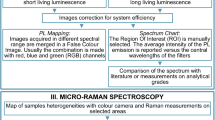Abstract
Prussian blue (PB) is an artists’ pigment that has been frequently used in many artworks but poses several problems of conservation because of its fading under light and anoxia treatment. PB fading is due to the reduction of iron(III) into iron(II) and depends a lot on the object investigated. Due to the complexity of the structure, the precise physico-chemical mechanisms behind the redox process remain obscure. In this paper, we present a procedure to investigate light- and anoxia-induced fading of PB-paper samples by means of time resolved X-ray absorption spectroscopy performed at the Fe K-edge. A system composed of a visible light source and a flux-controlled environmental cell allowed light, gas and humidity to be modified in situ. The synchrotron X-ray beam was evidenced to induce a reduction of PB and to play a major role in the kinetics. The analysis of the PB fading kinetics of a sample submitted to various gas and light environments showed that both synchrotron beam and anoxia were influencing PB reduction in a correlated way. In comparison, light was found to play a minor role. Finally, we have demonstrated that the type of paper substrate could influence significantly the kinetics of reduction. Several hypotheses to explain the correlation between PB reduction mechanism and substrate are presented.






Similar content being viewed by others
Notes
Unfortunately, the kinetics experiments performed on samples in Air–Light environment were discarded because of problems with light focus.
The total exposure time to measure one XANES spectrum is 20.3 s for an average spectrum (3 ms collection time + 200 ms lecture, i.e., 203 ms/frame, average spectrum obtained on 100 frames). No change was observed during these 100 frames, so that it is very unlikely that SR beam damage occurred during the measurement of individual XANES spectra.
An estimation of the absorbed energy, expressed in J, is: absorbed flux × 7120 eV × exposition time × 1.6.10−19.
References
J. Bartoll, B. Jackisch, Z. Kunsttechnol. Konserv. 21(1), 88 (2010)
M. Ware, J. Chem. Educ. 85(5), 612 (2008)
S. Rowe, Stud. Conserv. 49(4), 259 (2004)
H.J. Buser, D. Schwarzenbach, W. Petter, A. Ludi, Inorg. Chem. 16(11), 2704 (1977)
F. Herren, P. Fischer, A. Ludi, W. Halg, Inorg. Chem. 19(4), 956 (1980)
M. Verdaguer, Science 272(5262), 698 (1996)
P.R. Bueno, F.F. Ferreira, D. Gimenez-Romero, G.O. Setti, R.C. Faria, C. Gabrielli, H. Perrot, J.J. Garcia-Jareno, F. Vicente, J. Phys. Chem. C 112(34), 13264 (2008)
C. Gervais, M.A. Languille, S. Reguer, M. Gillet, E.P. Vicenzi, L. Bertrand, Submitted
A. Bleuzen, C. Lomenech, V. Escax, F. Villain, F. Varret, C.C.D. Moulin, M. Verdaguer, J. Am. Chem. Soc. 122(28), 6648 (2000)
A. Bleuzen, V. Escax, A. Ferrier, F. Villain, M. Verdaguer, P. Munsch, J.P. Itie, Angew. Chem., Int. Ed. Engl. 43(28), 3728 (2004)
Z.L. Lu, X.Y. Wang, Z.L. Liu, F.H. Liao, S. Gao, R.G. Xiong, H.W. Ma, D.Q. Zhang, D.B. Zhu, Inorg. Chem. 45(3), 999 (2006)
M. Vidotti, S.I.C. de Torresi, J. Braz. Chem. Soc. 19(7), 1248 (2008)
R. Koncki, T. Lenarczuk, A. Radomska, S. Glab, Analyst 126(7), 1080 (2001)
L. Samain, G. Silversmit, J. Sanyova, B. Vekemans, H. Salomon, B. Gilbert, F. Grandjean, G.J. Long, R.P. Hermann, L. Vincze, D. Strivaya, J. Anal. At. Spectrom. 26, 930 (2011)
J.M. del Hoyo-Meléndez, M.F. Mecklenburg, Spectrosc. Lett. 44(2), 113 (2011)
S. Schroeder, N. Tsapatsaris, N. Eastaugh, in 8th European Conference on Research for Protection, Conservation and Enhancement of Cultural Heritage, ed. by J. Kolar, Ljubljana, Slovenia, November 10–12 (2008), pp. 50–51
A. Dostal, G. Kauschka, S.J. Reddy, F. Scholz, J. Electroanal. Chem. 406(1–2), 155 (1996)
A. Lerwill, J.H. Townsend, H. Liang, S. Hackney, J. Thomas, Opt. Arts Archit. Archaeol. 6618, 66181G (2007)
F. Baudelet, Q. Kong, L. Nataf, J.D. Cafun, A. Congeduti, A. Monza, S. Chagnot, J.P. Itié, High Press. Res. 31(1), 136 (2011)
M. Newville, J. Synchrotron Radiat. 8, 322 (2001)
K. Hayakawa, K. Hatada, P. D’Angelo, S. Della Longa, C.R. Natoli, M. Benfatto, J. Am. Chem. Soc. 126, 15618 (2004)
B. Cochain, D.R. Neuville, D. De Ligny, J. Roux, F. Baudelet, E. Strukelj, P. Richet, J. Phys. Conf. Ser. 190, 012182 (2009)
J.W. Murray, E.F. Garman, R.B.G. Ravelli, J. Appl. Crystallogr. 37, 513 (2004)
J.M. Holton, J. Synchrotron Radiat. 16, 133–142 (2009)
J.A. Schmidt, C.S. Rye, N. Gurnagul, Polym. Degrad. Stab. 49(2), 291 (1995)
J.H. Townsend, J. Thomas, S. Hackney, A. Lerwill, Stud. Conserv. 1(Suppl.), 76 (2008)
Acknowledgements
We would like to acknowledge Lucie Nataf of the ODE team and Frédéric Picca for his joyful and spontaneous help in python programming. Thanks also to the team of the Soleil Chemistry Laboratory for help in preparing PB-paper samples and Matjia Strlic for sharing with us interesting points on paper aging process. We thank Robert J. Koestler for suggesting us to investigate PB fading in cultural artefacts. Claire Gervais thanks the Swiss National Science Foundation for partial funding through the SNSF Professorship grant 138986. This work has been developed as part of the IPANEMA/Smithsonian Institution agreement on science cooperation.
Author information
Authors and Affiliations
Corresponding author
Rights and permissions
About this article
Cite this article
Gervais, C., Languille, MA., Reguer, S. et al. “Live” Prussian blue fading by time-resolved X-ray absorption spectroscopy. Appl. Phys. A 111, 15–22 (2013). https://doi.org/10.1007/s00339-013-7581-y
Received:
Accepted:
Published:
Issue Date:
DOI: https://doi.org/10.1007/s00339-013-7581-y




